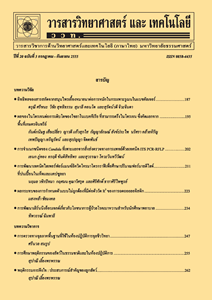การประเมินผลกระทบจากการเผาชีวมวลต่อระดับฝุ่นละอองขนาดเล็กกว่า 10 ไมครอน (PM10) ในช่วงที่มีปัญหาหมอกควันในพื้นที่ประเทศไทยโดยใช้แบบจำลอง WRF-CMAQ
Main Article Content
Abstract
Abstract
Biomass burning is an important source of PM10 in Thailand. Unusually high levels of PM10 were observed in summer season. The WRF-CMAQ (weather research and forecasting, WRF) and community multiscale air quality, CMAQ) modeling system was applied to assess the impact of biomass burning on PM10 in Thailand during smog episode in March 2012. It was found that the biomass burning contributed 72 % in Thailand. Especially in the Northern Thailand, the impact of biomass burning is very significant with contribution of 94%. While in the other region of Thailand, the contribution from biomass burning to PM10 was in the range of 56-78 %. The results reveal that the biomass burning is a main source of PM10 during summer season in Thailand. Therefore, air quality management should focus on open burning sources in Thailand and surrounding countries.
Keywords: biomass burning; air quality impact assessment; smog, Northern Thailand; PM10; WRF-CMAQ
Article Details
References
[2] Hao, W.M. and Liu, M.H., 1994, Spatial and temporal distribution of tropical biomass burning, Global Biogeochem. Cycles 8: 495-503.
[3] Reid Jeffrey S., Hyer, E., Johnson, R., Holben, B.N., Yokelson, R., et al., 2013, Observing and understanding the Southeast Asian aerosol system by remote sensing: An initial review and analysis for the Seven Southeast Asian Studies (7SEAS) program, Atmospheric Res. 122: 403-468.
[4] วิจารย์ สิมาฉายา, 2554, มลพิษจากหมอกควันในพื้นที่ภาคเหนือ : ปัญหาและแนวทาง, แหล่งที่ มา : http://www.pcd.go.th/info_serv/air_ thaihaze.html#h4, มีนาคม 2560.
[5] Fowler, C.T., 2003, Human health impacts of forest fires in the Southern United States: A literature review, J. Ecol. Anthropol. 7: 39-63.
[6] สิทธิชัย พิมลศรี และภวัต อารินทร์, 2553, สถานการณ์ปัญหาฝุ่นละอองในบรรยากาศและผลกระทบต่อสุขภาพประชาชนในจังหวัดลำปาง, นเรศวรวิจัย ครั้งที่ 6, มหาวิทยาลัยนเรศวร, พิษณุโลก.
[7] Kanabkaew, T. and Kim Oanh, N.T., 2011, Development of spatial and temporal emission inventory for crop residue field burning, Environ. Model. Assess. 16: 453-464.
[8] Gadde, B., Bonneta, S., Menkeb, C. and Garivaita, S., 2009, Air pollutant emissions from rice straw open field burning in India, Thailand and the Philippines, Environ. Pollut. 157: 1554-1558.
[9] Cheewaphongphan, P. and Garivait, S., 2013, Bottom up approach to estimate air pollution of rice residue open burning in Thailand, Asia-Pacific J. Atmosph. Sci. 49: 139-149.
[10] Junpen, A., Garivait, S. and Bonnet, S., 2013, Estimating emissions from forest fires in Thailand using MODIS active fire product and country specific data, Asia-Pacific J. Atmosph. Sci. 49: 389-400.
[11] Tsai, Y.I., Sopajareec, K., Chotruksa, A., Wu, H.C. and Kuo, S.C., 2013, Source indicators of biomass burning associated with inorganic salts and carboxylates in dry season ambient aerosol in Chiang Mai Basin, Thailand, Atmosph. Environ. 78: 93-104.
[12] Chantara, S., Sillapapiromsuk, S. and Wiriya, W., 2012, Atmospheric pollutants in Chiang Mai (Thailand) over a five-year period (2005-2009), their possible sources and relation to air mass movement, Atmosph. Environ. 60: 88-98.
[13] Kim Oanh, N.T. and Leelasakultum, K., 2011, Analysis of meteorology and emission in haze episode prevalence over mountain-bounded region for early warning, Sci. Total Environ. 409: 2261-2271.
[14] เกษมสันต์ มโนมัยพิบูลย์, 2552, การพัฒนาระบบแบบจำลองทางคณิตศาสตร์เบื้องต้นเพื่อให้ในงานพยากรณ์เตือนภัยมลภาวะหมอกควันสำหรับภาคเหนือตอนบนของประเทศไทยและการประยุกต์ใช้ในฤดูไฟป่าหน้าแล้ง, แหล่งที่มา : http://www.aqnis.pcd.go.th/project/northernhaze2551, มีนาคม 2560.
[15] วาฑิต วทัญญูไพศาล และนริศรา ทองบุญชู, 2552, แบบจําลองแบบบูรณาการเพื่อใช้ในการศึกษาความเป็นไปของมลพิษทางอากาศจากไฟป่าในภูมิภาคเอเชียตะวันออกเฉียงใต้, วิศวสารลาดกระบัง 26(2): 31-37.
[16] Teerachai, A. and Jiemjai, K., 2012, Investigation of fine and coarse particulate matter from burning areas in Chiang Mai, Thailand using the WRF/ CALPUFF, J. Sci. Fac. Chiang Mai Univ. 39: 311-326.
[17] Byun, D.W. and Ching, J.K.S., 1999, Science algorithms of the EPA Models-3 Community Multiscale Air Quality (CMAQ), U.S. Environmental Protection Agency, Washington, D.C.: EPA/600/R-99/030 (NTIS
PB2000-100561).
[18]. Wang, L., Hao, J., He, K., Wang, S., Li, J., Zhang, O., Streets, D.G., Fu, J.S., Jang, C.J., Takekawa, H. and Chatani, S., 2008, A modeling study of coarse particulate matter pollution in Beijing: regional source contributions and control implications for the 2008 Summer Olympics, J. Air Waste Manag. Assoc. 58: 1057-1069.
[19] Huang, K., Fu, J.S., Hsu, C.N., Gao, Y., Dong, X., Tsay, S.C. and Lam, Y.F., 2013, Impact assessment of biomass burning on air quality in Southeast and East Asia during BASE-ASIA, Atmosph. Environ. 78: 291-302.
[20] Cheng, Z., Wang, S., Fu, X., Watson, J.G., Jiang, J., Fu, Q., Chen, C., Xu, B., Yu, J., Chow, J.C. and Hao, J., 2014, Impact of biomass burning on haze pollution in the Yangtze River delta, China: a case study in summer 2011, Atmos. Chem. Phys 14: 4573-4585.
[21] Skamarock, W.C., Klemp, J.B., Dudhia, J., Gill, D.O., Barker, D.M., Duda, M.G., Huang, X.Y., Wang, W. and Powers, J.G., 2008, A Description of the Advanced Research WRF Version 3. NCAR Technical Note NCAR/TN-475+STR, B. NCAR, CO, USA.
[22] Lu, Z. and Streets, D.G., The Southeast Asia Composition, Cloud, Climate Coupling Regional Study Emission Inventory, Available Source: http://bio. cgrer.uiowa.edu/SEAC4RS/html, March 2016.
[23] Andela, N., Kaiser, J.W., Heil, A., van Leeuwen, T.T., van der Werf, G.R., Wooster, M.J., Remy, S. and Schultz, M., 2013, Assessment of the Global Fire Assimilation System (GFASv1), JuSER, April: 1-75, FZJ-2015-00718.
[24] Shi, Y., Matsunaga, T., Saito, M., Yamaguchi, Y. and Chen, X., 2015, Comparison of global inventories of CO2 emissions from biomass burning during 2002-2011 derived from multiple satellite products, Environ. Pollut. 206: 479-487.
[25] Chuang, M.T., Fu, J.S., Lin, N.H., Lee, C.T. and Gao, Y., et al., 2015, Simulating the transport and chemical evolution of biomass burning pollutants originating from Southeast Asia during 7-SEAS/2010 Dongsha experiment, Atmosph. Environ. 112: 294-305.
[26] Fu, J.S., Hsu, N.C., Gao, Y., Huang, K., Li, C., Lin, N.H. and Tsay, S.C., 2012, Evaluating the influences of biomass burning during 2006 BASE-ASIA: A regional chemical transport modeling, Atmos. Chem. Phys 12: 3837-3855.
[27] Vongruang, P., Wongwises, P. and Pimonsree, S., 2017, Assessment of fire emission inventories for simulating particulate matter in Upper Southeast Asia using WRF-CMAQ, Atmosph. Pollut. Res. (in press).

